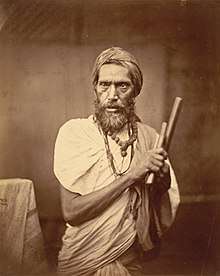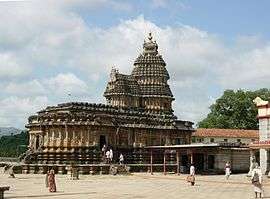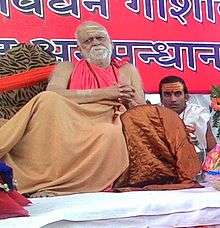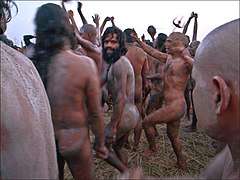Dashanami Sampradaya
Dashanami (IAST Daśanāmi Saṃpradāya "Tradition of Ten Names"), also known as the Order of Swamis,[1] is a Hindu monastic tradition of "single-staff renunciation" (ēka daṇḍi saṃnyāsī)[2][3][4] generally associated with the Vedanta tradition and organized in its present form by 8th-century theologian Adi Shankara.
| Part of a series on |
| Advaita |
|---|
 |
|
Schools |
|
Concepts Classical Advaita vedanta
Kashmir Shaivism |
|
Practices |
|
Texts Advaita Vedanta
Kashmir Shaivism Inchegeri Sampradaya |
|
Teachers Classical Advaita Vedanta
Modern Advaita Vedanta
Shaivism/Tantra/Nath
Neo-Advaita Other |
|
Influences Hinduism Buddhism |
|
Monasteries and Orders Classical Advaita Vedanta
Modern Advaita Vedanta Neo-Vedanta |
|
Scholarship
|
|
Categories
|
A swami, as the monk is called, is a renunciate who seeks to achieve spiritual union with the swa (Self). In formally renouncing the world, he or she generally wears ochre, saffron or orange-colored robes as a symbol of non-attachment to worldly desires, and may choose to roam independently or join an ashram or other spiritual organizations, typically in an ideal of selfless service.[1] Upon initiation, which can only be done by another existing Swami, the renunciate receives a new name (usually ending in ananda, meaning 'supreme bliss') and takes a title which formalizes his connection with one of the ten subdivisions of the Swami Order. A swami's name has a dual significance, representing the attainment of supreme bliss through some divine quality or state (i.e. love, wisdom, service, yoga - i.e. Yogananda), and through a harmony with the infinite vastness of nature, expressed in one of the ten subdivision names: Giri (mountain), Puri (tract), Bhāratī (land), Vana (forest), Āraṇya (forest), Kunwar(jogi), Sagara (sea), Āśrama (spiritual exertion), Sarasvatī (wisdom of nature), Tīrtha (place of pilgrimage), and Parvata (mountain). A swami is not necessarily a yogi, although many swamis can and do practice yoga as a means of spiritual liberation; experienced swamis may also take disciples.[1]
Dashanami Sannyāsins are associated mainly with the four maṭhas, established in four corners of India by Shankara himself; however, the association of the Dasanāmis with the Shankara maṭhas remained nominal.[web 1] The early swamis, elevated into the order as disciples of Shankara, were sannyāsins who embraced sannyas either after marriage or without getting married.
Single-staff renunciates are distinct in their practices from Shaiva trishuldhari or "trident-wielding renunciates" and Vaishnava traditions of Tridandi sannyāsis.[5][note 1][note 2] Any Hindu, irrespective of class, caste, age or gender can seek sannyāsa as an Ēkadaṇḍi renunciate in the Dasanāmi tradition.
History
%2C_f.363v_-_BL_Add._27255.jpg)
Ēkadaṇḍis
Ēkadandis were already known during what is sometimes referred to as "Golden Age of Hinduism" (ca. 320-650 CE[6])
Golden Age of Hinduism
- See also Gupta rule and Gupta and Pallava period
The "Golden Age of Hinduism"[6] (ca. 320-650 CE[6]) flourished during the Gupta Empire[7] (320 to 550 CE) until the fall of the Harsha[7] (606 to 647 CE). During this period, power was centralized, along with a growth of long distance trade, standardization of legal procedures, and a general spread of literacy.[7] Mahayana Buddhism flourished, but orthodox Shrauta Hinduism was rejuvenated by the patronage of the Gupta dynasty.[8] The position of the Brahmans was reinforced[7] and the first Hindu temples emerged during the late Gupta age.[7] The Mahābhārata, which probably reached its final form by the early Gupta period (c. 4th century),[9] already mentions "ēkadaṇḍi" and "tridaṇḍi".[10]
Wandering Ēkadaṇḍi ascetics

The Ēkadaṇḍis existed in the Tamil country during the south-Indian Pandyan dynasty (3rd century BCE - 16th century CE) and the South-Indian Pallava dynasty (2nd - 9th centuries CE). Being wandering monastics, they were not settled in the brahmadeyas or settlement areas for Brahmins. There existed tax free bhiksha-bogams for feeding the Ēkadaṇḍi ascetics in the ancient Tamil country.[11]
Ēkadaṇḍis and Tridandis were also active in Eastern India, and appear to have existed there during the North-Indian Gupta Empire (320 to 550 CE ).[12]
According to R. Tirumalai, "There appears to have been no sectarian segregation of the Shaiva (Ēkadaṇḍi) and Srivaishnava (Tridandi Sannyāsins)".[13]
Establishment of the Dasanami Sampradaya

At the beginning of what is referred to as "Late classical Hinduism",[14] which lasted from 650 till 1100 CE,[14] Shankara established the Dasanami Sampradaya.
Late-Classical Hinduism
- See also Late-Classical Age and Hinduism Middle Ages
After the end of the Gupta Empire and the collapse of the Harsha Empire, power became decentralized in India. Several larger kingdoms emerged, with "countless vassal states":[15] in the east the Pala Empire[15] (770-1125 CE[15]), in the west and north the Gurjara-Pratihara[15] (7th-10th century[15]), in the southwest the Rashtrakuta dynasty[15] (752-973[15]), in the Dekkhan the Chalukya dynasty[15] (7th-8th century[15]), and in the south the Pallava dynasty[15] (7th-9th century[15]) and the Chola dynasty[15] (9th century[15]).
The kingdoms were ruled via a feudal system. Smaller kingdoms were dependent on the protection of the larger kingdoms. "The great king was remote, was exalted and deified",[16] as reflected in the Tantric Mandala, which could also depict the king as the centre of the mandala.[17]
The disintegration of central power also lead to regionalization of religiosity, and religious rivalry.[18][note 3] Local cults and languages were enhanced, and the influence of "Brahmanic ritualistic Hinduism"[18] was diminished.[18] Rural and devotional movements arose, along with Shaivism, Vaisnavism, Bhakti and Tantra,[18] though "sectarian groupings were only at the beginning of their development".[18] Religious movements had to compete for recognition by the local lords.[18] Buddhism lost its position, and began to disappear in India.[18]
Establishment

Shankara, himself considered to be an incarnation of Shiva,[web 1] established the Dashanami Sampradaya, organizing a section of the Ēkadaṇḍi monastics under an umbrella grouping of ten names.[web 1] Several other Hindu monastic and Ēkadaṇḍi traditions remained outside the organization of the Dasanāmis.[20][21][22]
Adi Shankara organized the Hindu monastics of these ten sects or names under four maṭhas or monasteries, with headquarters at Dvārakā in the west, Jagannathadham Puri in the east, Sringeri in the south and Badrikashrama in the north.[web 1] Each maṭha was headed by one of his four main disciples, who each continued the Vedanta Sampradaya.
Monastics of these ten orders differ in part in their beliefs and practices, and a section of them is not considered to be restricted to specific changes made by Shankara. While the Dasanāmis associated with the Shankara maṭhas follow the procedures enumerated by Adi Śankara, some of these orders remained partly or fully independent in their belief and practices; and outside the official control of the Shankara maṭhas.
The association of the Dasanāmis with the Smartha tradition or Advaita Vedānta is not all-embracing. One example is the Kriyā Yoga tradition that considers itself eclectic (see: Eclecticism), with ancient[web 2] unchangeable beliefs, and outside the ambit of differences in the understanding of Vedanta. Other examples are the Tantric Avadhūta Sampradāyas and Ekadaṇḍi sannyāsa traditions outside the control of the Shankara maṭhas[22] The Dasanāmis or Ēkadaṇḍis also founded, and continue to found or affiliate themselves with, maṭhas, ashrams and temples outside the control of the Shankara maṭhas.[web 2][web 3]
The Advaita Sampradāya is not a Shaiva sect,[web 1][23] despite the historical links with Shaivism:
Advaitins are non-sectarian, and they advocate worship of Siva and Visnu equally with that of the other deities of Hinduism, like Sakti, Ganapati and others.[web 1]
Nevertheless, contemporary Shankaracaryas have more influence among Saiva communities than among Vaisnava communities.[web 1] The greatest influence of the gurus of the Advaita tradition has been among followers of the Smartha tradition, who integrate the domestic Vedic ritual with devotional aspects of Hinduism.[web 1]
According to Nakamura, these maṭhas contributed to the influence of Shankara, which was "due to institutional factors".[24] The maṭhas which he built exist until today, and preserve the teachings and influence of Shankara, "while the writings of other scholars before him came to be forgotten with the passage of time".[25]
The table below gives an overview of the four Amnaya maṭhas founded by Adi Shankara, and their details.[web 4]
| Shishya (lineage) |
Direction | Maṭha | Mahāvākya | Veda | Sampradaya |
|---|---|---|---|---|---|
| Padmapāda | East | Govardhana Pīṭhaṃ | Prajñānam brahma (Consciousness is Brahman) | Rig Veda | Bhogavala |
| Sureśvara | South | Sringeri Śārada Pīṭhaṃ | Aham brahmāsmi (I am Brahman) | Yajur Veda | Bhūrivala |
| Hastāmalakācārya | West | Dvāraka Pīṭhaṃ | Tattvamasi (That thou art) | Sama Veda | Kitavala |
| Toṭakācārya | North | Jyotirmaṭha Pīṭhaṃ | Ayamātmā brahma (This Atman is Brahman) | Atharva Veda | Nandavala |
Expansion of the Dasanāmi Sampradāya
According to the tradition in Kerala, after Shankara's samādhi at Vadakkunnathan Temple, his disciples founded four maṭhas in Thrissur, namely Naduvil Madhom, Thekke Madhom, Idayil Madhom and Vadakke Madhom.
According to Pandey, the ēkadaṇḍis or Dasanāmis had established monasteries in India and Nepal in the 13th and 14th century.[web 5]
Naga Sadhus akharas

In the 16th century, Madhusudana Saraswati of Bengal organised a section of the Naga (naked) tradition of armed sannyasis in order to protect Hindus from the tyranny of the Mughal rulers. These are also called Gusain, Gussain, Gosain, Gossain, Gosine, Gosavi, Sannyāsi.
Warrior-ascetics could be found in Hinduism from at least the 1500s and as late as the 1700s,[26] although tradition attributes their creation to Sankaracharya[web 6]
Some examples of Akhara currently are the Juna Akhara of the Dashanami Naga, Niranjani Akhara, Anand Akhara, Atal Akhara, Awahan Akhara, Agni Akhara and Nirmal Panchayati Akhara at Allahabad.[web 7] Each akhara is divided into sub-branches and traditions. An example is the Dattatreya Akhara (Ujjain) of the naked sadhus of Juna Naga establishment.[web 8]
The naga sadhus generally remain in the ambit of non-violence presently, though some sections are also known to practice the sport of wrestling. The Dasanāmi sannyāsins practice the Vedic and yogic Yama principles of ahimsā (non-violence), satya (truth), asteya (non-stealing), aparigraha (non-covetousness) and brahmacārya (celibacy / moderation).
The naga sadhus are prominent at Kumbh mela, where the order in which they enter the water is fixed by tradition. After the Juna akhara, the Niranjani and Mahanirvani Akhara proceed to their bath. Ramakrishna Math Sevashram are almost the last in the procession.[27]
Characteristics
Parampara
In the Indian religious and philosophical traditions, all knowledge is traced back to the gods and to the Rishis who primarily envisioned the Vedas.
The current Acaryas, the heads of the maṭhas, trace their authority back to the four main disciples of Shankara,[web 9] and each of the heads of these four maṭhas takes the title of Shankaracharya ("the learned Shankara") after Adi Shankara.
The Advaita guru-paramparā (Lineage of Gurus in Non-dualism) begins with the mythological time of the Daiva-paramparā, followed by the vedic seers of the Ṛṣi-paramparā, and the Mānava-paramparā of historical times and personalities:[web 9][note 4]
- Daiva-paramparā
- Ṛṣi-paramparā
- Mānava-paramparā
- Gauḍapāda
- Govinda bhagavatpāda
- Śankara bhagavatpāda, and then Shankara's four disciples
- Padmapāda
- Hastāmalaka
- Toṭaka
- Vārtikakāra (Sureśvara) and others
Ten Names
Hindus who enter sannyāsa in the ēkadaṇḍi tradition take up one of the ten names associated with this sampradaya: Giri, Puri, Bhāratī, Vana, Āraṇya, Sagara, Āśrama, Sarasvatī, Tīrtha, and Parvata.[web 11][web 1]
Standardised List of Notable Dasanāmīs
This section enumerates, in standardised manner, members of the Dasanāmī Order with articles in Wikipedia, listing each under his formal title and name, without the use of the honorifics[note 6] so cherished by fawning devotees and disciples. The word "swāmī" here is not an honorific. It is the title of an initiated member of the Dasanāmī Order. Entries are listed in standard form: TITLE (SWĀMĪ) + PERSONAL NAME + SUB-ORDER NAME. A few entries have the additional title (not honorific) of "Jagadguru Śankarācārya" which designates either one of the four supreme leaders of the order (somewhat similar to the position of Pope in Catholic Christianity). "Mahanta" is an administrative title designating an organizational position or office assigned to certain persons.
A
| Name | Notability |
|---|---|
| Swāmī Abhayānanda Puri | French American initiate of Vivekānanda. |
| Swāmī Abhedānanda Puri | Disciple of Rāmakrsna. |
| Swāmī Abhinavavidyā Tīrtha | Jagadguru Śankarācārya of Śrngeri. |
| Swāmī Achalānanda Puri | Disciple of Vivekānanda. |
| Swāmī Achyutananda Sarasvatī | Social reformer and religious figure from the Advaita family. Achintya Bheda Abheda |
| Swāmī Adbhutānanda Puri | Disciple of Rāmakrsna. |
| Swāmī Adidevānanda Puri | Ramakrishna monk. |
| Swāmī Advaitānanda Puri | Disciple of Rāmakrsna. |
| Swāmī Agehānanda Bhāratī | Austrian American intellectual and expert on Indian languages and phonology. |
| Swāmī Agnivesha Sarasvatī | Activist; reformer; interfaith dialog advocate. |
| Swāmī Akhandānanda Puri | Disciple of Rāmakrsna. |
| Swāmī Akhandānanda Sarasvatī | Preacher of Bhagavata Purana. |
| Swāmī Akhilānanda Puri | Founder of Vedanta Society of Providence and Ramakrishna Vedanta Society of Boston. |
| Swāmī Akshobhya Tīrtha | Dvaitavādin. |
| Swāmī Ānanda Tīrtha | Preceptor of Dvaita. |
| Swāmī Ānandānanda Puri | Gandhian activist. |
| Swāmī Ashokānanda Puri | Ramakrishna monk. |
| Swāmī Atmabodhendra Sarasvatī | Pīthādhipati of Kamakoti Math, Kanchipuram. |
| Swāmī Ātmājñānānanda Puri | American Ramakrishna monk. |
| Swāmī Ātmasthānanda Puri | President of the Ramakrishna Mission. |
B
| Name | Notability |
|---|---|
| Swāmī Bhāratī Tīrtha | Jagadguru Śankarācārya of Śrngeri. |
| Swāmī Bhāratīkrsna Tīrtha | Jagadguru Śankarācārya of Puri and scholar of Indian mathematics. First Śankarācārya to visit the West. Authored Vedic Mathematics. |
| Swāmī Bhaskarānanda Sarasvatī | Scholar and anchorite of Benāres. |
| Swāmī Bhūmānanda Tīrtha | Social reformer. Teacher of Bhagavad Gita and Bhagavata Purana. |
| Swāmī Bhuteshānanda Puri | President of the Ramakrishna Mission. |
| Swāmī Bodhānanda Sarasvatī | Disciple of Sivānanda. |
| Swāmī Bodhendra Sarasvatī | Pīthādhipati of Kamakoti Math, Kanchipuram. |
| Swāmī Brahmānanda Sarasvatī | Highly-respected Jagadguru Śankarācārya of Jyotirmāyā Pītha, Badrināth. |
C
| Name | Notability |
|---|---|
| Swāmī Chandrachudhendra Sarasvatī | Pīthādhipati of Kamakoti Math, Kanchipuram. |
| Swāmī Candrasekhara Bhāratī | Jagadguru Śankarācārya of Śrngeri. |
| Swāmī Chandrasekharendra Sarasvatī | Pīthādhipati of Kanchi Kamakoti Peetham, Kanchipuram. Featured in Paul Brunton's A Search in Secret India. |
| Swāmī Chidānanda Sarasvatī | Disciple of Svāmī Śivānanda Sarasvatī. President of Divine Life Society. Interfaith advocate and friend of Thích Nhất Hạnh. |
| Swāmī Chidānanda Sarasvatī | Founder of temples in Australia, Canada, Europe, and the USA. |
| Swāmī Chidbhavānanda Puri | Ramakrishna monk. Prolific author. |
| Swāmī Chidvilasānanda Sarasvatī | Disciple and designated successor of Muktānanda. Sister of Nityānanda. |
| Swāmī Chinmāyānanda Sarasvatī | Hindu missionary. Disciple of Svāmī Śivānanda Sarasvatī and Svāmī Tapovanam Giri. Founder of Chinmaya Mission. |
D
| Name | Notability |
|---|---|
| Swāmī Dayānanda Sarasvatī | Socio-religious reformer and activist. Founder of the Arya Samaj. |
| Swāmī Dayānanda Sarasvatī | Vedānt ācārya. Founder of Arsha Vidya Gurukulam. |
| Swāmī Dhanarāja Giri | Advaita Vedānta ācārya. Founder of the highly-prestigious Kailash Ashram, Rishikesh. |
G
| Name | Notability |
|---|---|
| Swāmī Gahanānanda Puri | President of the Ramakrishna Mission. |
| Swāmī Gambhirānanda Puri | President of the Ramakrishna Mission. |
| Swāmī Ganapati Sarasvatī | Long-lived yogī of Benāres. |
| Swāmī Ganeshānanda Sarasvatī | Yoga teacher. Pupil and sannyās initiate of Swāmī Śivānanda Sarasvatī. Pupil of Swāmī Suraj Giri. |
| Swāmī Gangadharendra Sarasvatī | Teacher of Advaita Vedānta. |
| Swāmī Ghanānanda Puri | Ramakrishna monk who was active in Europe. |
| Swāmī Ghanānanda Sarasvatī | Ghanaian disciple of Svāmī Krishnānanda Sarasvatī. Possibly the first Black African convert to Hinduism. |
| Swāmī Gītānanda Giri | Indian Canadian physician. Yoga teacher; Mahanta of the Brighu Order; "Lion of Pondicherry". |
| Swāmī Gñānānanda Giri | Long-lived yogī. Guru of French Catholic monastic Abhishiktānanda. |
H
| Name | Notability |
|---|---|
| Swāmī Haridāsa Giri | Disciple of Svāmī Gñānānanda Giri. |
| Swāmī Hariharānanda Āranya | Noted Samkhya Yogī |
| Swāmī Hariharānanda Giri | Kriyā Yoga teacher. Pupil of Śrījukteśvara, Bhupendranāth Sanyal, Yogānanda, Satyānanda, and Bijoy Krishna. |
| Swāmī Hariharānanda Sarasvatī | Respected Vedānt ācārya. Disciple of Svāmī Brahmānanda Sarasvatī. Met Yogānanda at the Kumbh Mela. |
I
| Name | Notability |
|---|---|
| Swāmī Isvara Puri | Dvaitavādin. |
J
| Name | Notability |
|---|---|
| Swāmī Janakānanda Sarasvatī | Danish disciple of Svāmī Satyānanda Sarasvatī; founder of Skandinavisk Yoga och Meditationsskola. |
| Swāmī Jaya Tīrtha | Dvaitavādin. |
| Swāmī Jaya Tīrtha | Dvaitavādin. |
| Swāmī Jayendra Sarasvatī | Disciple of Svāmī Chandrasekharendra Sarasvatī. Pīthādhipati of Kamakoti Math, Kanchipuram. |
| Swāmī Jītātmānanda Puri | Ramakrishna monk. |
K
| Name | Notability |
|---|---|
| Swāmī Kalyanānanda Puri | Disciple of Vivekānanda. |
| Swāmī Kesavānanda Bhāratī | Mahānta/Pīthādhipati of Edneer Math, Kasaragod district, Kerala. |
| Swāmī Kesavānanda Tīrtha | Yogī of Vrindāban. |
| Swāmī Kirtidānanda Puri | Ramakrishna monk. |
| Swāmī Krishnānanda Sarasvatī | Disciple of Śivānanda; General Secretary of Divine Life Society, 1963-2001. |
| Swāmī Kriyānanda Giri | American disciple of Yogānanda. Founder of Ananda World Brotherhood Colonies. |
| Swāmī Kṛṣṇacaitanya Bhāratī | Vaisnava teacher and scholar of Bengal; regarded as an avatār in Bangla Vaisnavism. Called "Caitanya Mahaprabhu" by devotees. |
L
| Name | Notability |
|---|---|
| Swāmī Laksmanānanda Sarasvatī | Humanitarian social relief worker of Orissa. assassinated by suspected Christian Maoists. |
| Swāmī Laksmīnārāyana Tīrtha | Dvaitavādin. |
M
| Name | Notability |
|---|---|
| Swāmī Madhavānanda Puri | President of the Ramakrishna Mission. |
| Swāmī Madhavendra Puri | Dvaitavādin. Disciple of Lakshmipati Tirtha. |
| Swāmī Madhusūdana Sarasvatī | Teacher of Advaita Vedānta. |
| Swāmī Mahādevendra Sarasvatī | Pīthādhipati of Kamakoti Math, Kanchipuram. |
| Swāminī Māyātitānanda Sarasvatī | Ayurveda teacher. |
| Swāmī Muktānanda Sarasvatī | Meditation teacher. Founded the SYDA (Siddha Yoga Dham) organization, with several ashrams and centers. Author. |
N
| Name | Notability |
|---|---|
| Swāmī Nāmānanda Giri | Disciple of Haridāsa Giri. |
| Swāmī Narahari Tīrtha | Dvaitavādin. Disciple of Swāmī Ānanda Tīrtha. |
| Swāmī Nārāyanānanda Puri | Ramakrishna monk. Rāja yoga teacher in Denmark. |
| Swāmī Nigamānanda Sarasvatī | Bhakta, gyānī, yogī, tantrika of Eastern India. |
| Swāmī Nikhilānanda Puri | Ramakrishna monastic; Vedānta teacher in the USA. |
| Swāmī Nirañjanānanda Puri | One of the six disciples of Rāmakrsna who were regarded as iśvarakoti. |
| Swāmī Nirañjanānanda Sarasvatī | Disciple of Satyānanda; head of Bihar School of Yoga. |
| Swāmī Nirmalānanda Puri | Disciple of Rāmakrsna. |
| Swāmī Nischayānanda Puri | Disciple of Vivekānanda. |
| Swāmī Nrsimha Sarasvatī | Sage of Mahārāshtra. Regarded as an incarnation of the legendary sage Dattātreya. |
O
| Name | Notability |
|---|---|
| Swāmī Omānanda Puri | Irish violinist, singer, theosophist, writer, poet, esoteric teacher and authority on Indian music. |
| Swāmī Omānanda Sarasvatī | Educator. |
P
| Name | Notability |
|---|---|
| Swāmī Padmanabha Tīrtha | Dvaitavādin. Disciple of Swāmī Ānanda Tīrtha. |
| Swāmī Paramānanda Puri | Ramakrishna monk. Vedānta teacher in the USA. |
| Swāmī Prabhavānanda Puri | Ramakrishna monk. Vedānta teacher in the USA. |
| Swāmī Prakāshānanda Puri | Ramakrishna monk; Vedānta teacher in the USA. |
| Swāmī Prakāshānanda Sarasvatī | Rādhā-Krsna devotee, convict and fugitive in the USA. Disciple of Rādhā-Krsna bhakta Kripālu "Mahārāj." |
| Swāmī Prakāshānanda Sarasvatī | Hindu teacher in Trinidad. |
| Swāmī Prameyānanda Puri | Ramakrishna monk. |
| Swami Pranavānanda Giri | Founder of Bharat Sevashram Sangha. |
| Swāmī Pranavānanda Sarasvatī | Disciple of Śivānanda; Yoga-Vedānta teacher, Divine Life Society, Malaysia. |
| Swāmī Premānanda Puri | One of the six disciples of Rāmakrsna who were regarded as iśvarakoti. |
| Swāmī Purnaprajñā Tīrtha | Preceptor of Dvaitavāda. |
| Swāmī Purushottamānanda Puri | Ramakrishna monk. |
R
| Name | Notability |
|---|---|
| Swāmī Raghavendra Tīrtha | Dvaitavādin. |
| Swāmī Raghaveshwara Bhāratī | Advaita Vedāntin. 36th Pīthādhipati of Ramachandrapura Math, Hosanagara, Shimoga, Karnātaka. |
| Swāmī Raghuttama Tīrtha | Dvaitavādin. |
| Swāmī Rāma Bhāratī | Yogī; founder of Himalayan International Institute of Yoga Science and Philosophy, Honesdale, Pennsylvania. |
| Swāmī Rāma Tīrtha | Teacher of "Practical Vedanta". |
| Swāmī Rāmakrishnānanda Puri | Disciple of Rāmakrsna. |
| Swāmī Rāmakrsna Puri | Temple priest, ascetic, mystic of Bengal. Regarded as an avatār (a "descent" or physical incarnation of God) by devotees. |
| Swāmī Rāmānanda Tīrtha | Activist in Hyderābād. |
| Swāmī Ranganāthānanda Puri | President of the Ramakrishna Mission and a great Vedantin. |
| Swāmī Rudrānanda Puri | Ramakrishna monk in Fiji. |
| Swāmī Rudrānanda Sarasvatī | American spiritual teacher. |
S
| Name | Notability |
|---|---|
| Swāmī Saccidānanda Bhāratī | Jagadguru Śankarācārya of Śrngeri. |
| Swāmī Saccidānanda Bhāratī | Jagadguru Śankarācārya of Śrngeri. |
| Swāmī Saccidānandaśivābhinavanrsiṃha Bhāratī | Jagadguru Śankarācārya of Śrngeri. |
| Swāmī Sadānanda Puri | Disciple of Vivekānanda. |
| Swāmī Sadaśivendra Sarasvatī | Scholar, yogī-siddha, poet, avadhūta; mentioned in Yogānanda's Autobiography of a Yogi. |
| Swāmī Sahajānanda Sarasvatī | Indian nationalist. |
| Swāmī Sahajānanda Sarasvatī | South African spiritual teacher. Disciple of Śivānanda. |
| Swāmī Samyamindra Tīrtha | Mathadhipati of Kashi Math. |
| Swāmī Śaradānanda Puri | Disciple of Rāmakrsna. Author of the Śrī Śrī Rāmakrsna Līlaprasanga, the lead biography of Rāmakrsna. |
| Swāmī Satchidānanda Sarasvatī | Yoga teacher. Disciple of Śivānanda. Founder of Sivananda Ashram (Sri Lanka) and Satchidananda Ashrams (USA). |
| Swāmī Satcidānandendra Sarasvatī | Vedānt ācārya. |
| Swāmī Satyānanda Giri | Kriyā Yoga teacher. Disciple of Śrījukteśvara. |
| Swāmī Satyānanda Sarasvatī | Disciple of Śivānanda; founder of Bihar School of Yoga. |
| Swāmī Satyanātha Tīrtha | Dvaitavādin. |
| Swāmī Satyapramoda Tīrtha | Dvaitavādin. |
| Swāmī Satyātmā Tīrtha | 42nd pontiff of Uttaradi Matha. |
| Swāmī Shambhavānanda Puri | Ramakrishna monk. |
| Swāmī Shankarānanda Puri | President of the Ramakrishna Mission. |
| Swāmī Shankarānanda Sarasvatī | American disciple of Muktānanda. |
| Swāmī Shantānanda Sarasvatī | Disciple of Śivānanda. Spiritual guide in Kuala Lumpur, Malaysia. |
| Swāmī Shivānanda Puri | Disciple of Rāmakrsna and 2nd President of the Ramakrishna Order. |
| Swāmī Shivom Tīrtha | Siddhayoga teacher. |
| Swāmī Shraddhānanda Sarasvatī | Hindu social activist. Assassinated by a Muslim. |
| Swāmī Shuddhānanda Puri | President of the Ramakrishna Mission. |
| Swāmī Śivānanda Sarasvatī | Founded Divine Life Society and Yoga-Vedanta Forest Academy, Rishikesh; authored 200 books. |
| Swāmī Śivānanda Rādhā Sarasvatī | Canadian yoga teacher. Disciple of Śivānanda. |
| Swāmī Smaranānanda Puri | Ramakrishna monk. President of the Ramakrishna Order. |
| Swāmī Śrījukteśvara Giri | Kriyā Yoga adept. Astrologer. Disciple of Shyāmacharan Lahirī. Guru of Yogānanda. |
| Swāmī Subodhānanda Puri | Disciple of Rāmakrsna. |
| Swāmī Sudhindra Tīrtha | Mathadhipati of Kashi Math. |
| Swāmī Sukrathindra Tīrtha | Mathadhipati of Kashi Math. |
| Swāmī Swahānanda Puri | Ramakrishna monk. |
| Swāmī Swarūpānanda Puri | Disciple of Vivekānanda. |
| Swāmī Swarūpānanda Sarasvatī | Jagadguru Śankarācārya of Jyotirmāyā and Dwarka Pītha. |
T
| Name | Notability |
|---|---|
| Swāmī Tapasyānanda Puri | Ramakrishna monk. |
| Swāmī Tapovanam Giri | Reclusive yogī of Uttar Kashi. |
| Swami Tejomayananda Saraswati | Current Head of Chinmaya Mission Worldwide. |
| Swāmī Trigunatitānanda Puri | Disciple of Rāmakrsna. |
| Swāmī Turiyānanda Puri | Disciple of Rāmakrsna. |
| Swāmī Tyagānanda Puri | Ramakrishna monk. Hindu chaplain of Massachusetts Institute of Technology. |
V
| Name | Notability |
|---|---|
| Swāmī Vadirāja Tīrtha | Dvaitavādin. |
| Swāmī Vasudevānanda Sarasvatī | Wandering monk, spiritual teacher, author. |
| Swāmī Venkateśānanda Sarasvatī | Disciple of Śivānanda; founder of Sivananda Ashrams in South Africa and Mauritius. |
| Swāmī Vidyānāthānanda Puri | Ramakrishna monk and mathematician. |
| Swāmī Vidyāranya Tīrtha | Jagadguru Śankarācārya of Śrngeri. |
| Swāmī Vidyātmānanda Puri | Ramakrishna monk. |
| Swāmī Vijayendra Sarasvatī | Disciple and designated successor of Jayendra Sarasvatī. |
| Swāmī Vijayendra Tīrtha | Dvaitavādin. |
| Swāmī Vijñānānanda Puri | Disciple of Rāmakrsna. |
| Swāmī Vimalānanda Puri | Disciple of Vivekānanda. |
| Swāmī Vipulānanda Puri | Srī Lankān Ramakrishna monastic and Hindu revivalist. |
| Swāmī Virajānanda Puri | President of the Ramakrishna Mission. |
| Swāmī Vireshwarānanda Puri | President of the Ramakrishna Mission. |
| Swāmī Vishnu Tīrtha | Siddhayoga teacher. |
| Swāmī Vishnudevānanda Sarasvatī | Yogī. Peace activist. Most famous disciple of Svāmī Śivānanda Sarasvatī (the two of them are the most well-known members of the Sarasvati sub-order). Founder of the worldwide Sivananda Yoga Vedanta Centres. Authored The Complete Illustrated Book of Yoga. Airplane pilot. |
| Swāmī Vishuddhānanda Puri | President of the Ramakrishna Mission. |
| Swāmī Vishwadevānanda Puri | Teacher of Advaita Vedānta. |
| Swāmī Vivekānanda Puri | Most famous of disciples of Ramakrishna (the two of them are the most well-known members of the Puri sub-order). Most famous figure at first Parliament of the World's Religions (Chicago, 1893). Organizer of the Ramakrishna Mission. One of the six disciples of Rāmakrsna who were regarded as iśvarakoti. |
| Swāmī Vyāsa Tīrtha | Dvaitavādin. |
| Swāmī Vyāsachalamahādevendra Sarasvatī | Pīthādhipati of Kamakoti Math, Kanchipuram. |
Y
| Name | Notability |
|---|---|
| Swāmī Yatīśwarānanda Puri | Ramakrishna monk. Spiritual teacher and meditation instructor. |
| Swāmī Yogānanda Giri[29] | Founder of Self-Realization Fellowship. Author of Autobiography of a Yogi. |
| Swāmī Yogānanda Giri | Leading Hindu of Italy. Disciple of Gītānanda. |
| Swāmī Yogānanda Puri | One of the six disciples of Rāmakrsna who were regarded as iśvarakoti. |
Notes
- The Tridandi sannyāsins continue to wear the sacred thread after renunciation, while Ekadandi sannyāsins do not.
- Ek means "one", ekadandi means "of single staff", tridandi means "of three staffs".
- This resembles the development of Chinese Chán during the An Lu-shan rebellion and the Five Dynasties and Ten Kingdoms Period (907–960/979), during which power became decentralized and new Chán-schools emerged.[19]
- The following Sanskrit Verse among Smarthas provides the list of the early teachers of the Vedanta in their order:[web 10][28]
"नारायणं पद्मभुवं वशिष्ठं शक्तिं च तत्पुत्रं पराशरं च व्यासं शुकं गौडपादं महान्तं गोविन्दयोगीन्द्रं अथास्य शिष्यम्
श्री शंकराचार्यं अथास्य पद्मपादं च हस्तामलकं च शिष्यम् तं तोटकं वार्त्तिककारमन्यान् अस्मद् गुरून् सन्ततमानतोऽस्मि
अद्वैत गुरु परंपरा स्तोत्रम्"
"nārāyanam padmabhuvam vasishtam saktim ca tat-putram parāśaram ca
vyāsam śukam gauḍapāda mahāntam govinda yogīndram athāsya śiṣyam
śri śankarācāryam athāsya padmapādam ca hastāmalakam ca śiṣyam
tam trotakam vārtikakāram-anyān asmad gurūn santatamānato’smi
Advaita-Guru-Paramparā-Stotram",
The above advaita guru paramparā verse salute the prominent gurus of advaita, starting from Nārāyaṇa through Adi Sankara and his disciples, up to the Acharyas of today. - the famous redactor of the vedas, he is also traditionally identified with Bādarāyaṇa, the composer of the Brahmasūtras
- e.g.: śrī, shri, shrii, shree, śrī śrī, śrī śrī śrī, śrīla, śrīman, jī, jiew, joo, jiu, swāmījī, mahātma, mahārsi, mahāyogī, mahāsaya, mahārāj, mahārājjī, prabhu, prabhujī, mahāprabhu, gurudev, gurujī, guru mahārāj jī, sāheb, sāhebjī, bābā, bābājī, mā, māta, mātajī, bhagvan, prabhupāda, bhaktipāda. Aside from these, "Paramahamsa" is also one of the most abused honorifics. Many unfit characters want to claim it; many adoring disciples apply it to their guru. It was used by the ISKCON rtvik/guru-ācāryas. However, the case of Swāmī Yogānanda Giri is a unique one, since his appellation "Paramahansa" was not given to him by adoring disciples.
References
Written references
- Yogananda, Paramhansa (1946). "Autobiography of a Yogi - Chpt 24: I Become a Monk of the Swami Order - pg 218". www.CrystalClarity.com.
- Journal of the Oriental Institute (pp 301), by Oriental Institute (Vadodara, India).
- Govind Sadashiv Ghurye, Indian Sadhus
- Lalit Kishore Lal Srivastava, Advaitic Concept of Jīvanmukti
- A. C. Bhaktivedānta Swāmi, Śrīmad Bhāgavatam
- Michaels 2004, p. 40-41.
- Michaels 2004, p. 40.
- Nakamura 2004, p. 687.
- Van Buitenen; The Mahabharata – 1; The Book of the Beginning. Introduction (Authorship and Date)
- Swāmi Parmeshwarānand, Encyclopaedia of Śaivism, p.82
- Shanmuga Velayutham Subramanian, Heritage of the Tamils: temple arts, p.154
- Bhagwati Charan Verma, Socio-religious, Economic, Literary Condition of Bihar
- R. Tirumalai, The Pandyan Townships : The Pandyan townships, their organisation and functioning
- Michaels 2004, p. 41-43.
- Michaels 2004, p. 41.
- michaels 2004, p. 41.
- White 2000, p. 25-28.
- Michaels 2004, p. 42.
- McRae 2003.
- Karigoudar Ishwaran, Ascetic Culture
- Wendy Sinclair-Brull, Female Ascetics
- H.A. Rose, Ibbetson, Denzil Ibbetson Sir, and Maclagan, Glossary of the Tribes and Castes of the Punjab and North West Frontier Province, page 857
- Nakamura 2004, p. 782-783.
- Nakamura 2004, p. 680.
- Nakamura 2004, p. 680-681.
- A history of Dasnami Naga Sanyasis, Sir Jadunath Sarkar, Sri Panchayati Akhara Mahanirvani, Allahabad, http://dspace.wbpublibnet.gov.in:8080/jspui/bitstream/10689/9526/5/Chapter%201_1%20-%20108p.pdf
- Naga sadhus steal the show at Kumbh, Nandita Sengupta, TNN Feb 13, 2010://articles.timesofindia.indiatimes.com/2010-02-13/india/28140014_1_naga-sadhus-juna-akhara-holy-dip
- Book: Shri Gowdapadacharya & Shri Kavale Math (A Commemoration volume). P. 38.
- Known by honorific "Paramahansa."
Web-references
- Devasthananam, Sankara Acarya Biography: Monastic Tradition
- Kalyanagiri
- Prajnana Mission
- "Adi Shankara's four Amnaya Peethams". Archived from the original on 26 June 2006. Retrieved 20 August 2006.
- The maṭhas of Dasanami Sanyasis of Lalitpur, Kathmandu Valley
- Nagas: Once were warriors. Gautam Siddharth, TNN Jan 15, 2013
- Prem Panicker, Where did the Akharas come from?
- divinerevelation.org, Kumbh Melas in Haridwar and Ujjain
- "The Advaita Vedânta Home Page — Advaita Parampara". Advaita-vedanta.org. 5 May 1999. Retrieved 10 September 2012.
- Under Page: BIOGRAPHICAL NOTES ABOUT SANKARA AND GAUDAPAD
- The Dashanami Sampradaya- the Monastic Tradition
Sources
- McRae, John (2003), Seeing Through Zen. Encounter, Transformation, and Genealogy in Chinese Chan Buddhism, The University Press Group Ltd, ISBN 9780520237988
- Michaels, Axel (2004), Hinduism. Past and present, Princeton, New Jersey: Princeton University Press
- Nakamura, Hajime (2004), A History of Early Vedanta Philosophy. Part Two, Delhi: Motilal Banarsidass Publishers Private Limited

